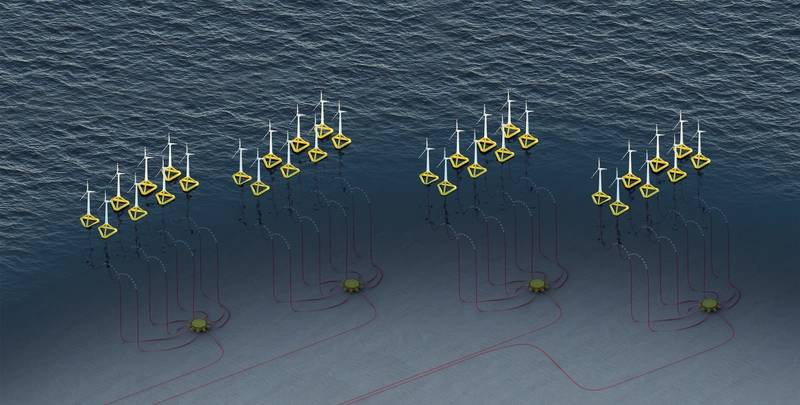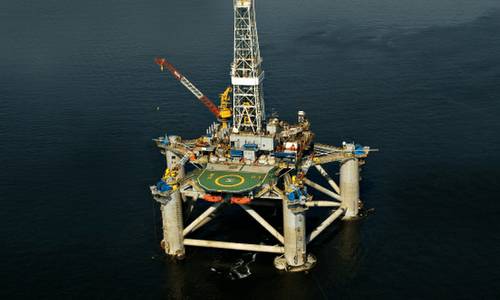Subsea Redesign Underway for Floating Offshore Wind
Wendy Laursen
December 23, 2024

The 66kV high voltage wet mate connector currently undergoing technical qualification by Baker Hughes weighs in at around one ton and has over 40 liters of dielectric oil protecting copper cable up to 1,200 square millimeters in diameter.
The connector is designed to sit on the seabed at the end of a dynamic cable coming from floating wind turbines and connect it to a collector hub that ultimately delivers the megawatts of energy it produces to a subsea substation and then to shore.
There’s a lot that could go wrong.
Cable failure is a high-cost problem for fixed offshore wind even though, like oil and gas applications, it involves static cabling. Dynamic cable failures are expected to be even more common when the floating wind industry takes off.
Baker Hughes has leveraged its oil and gas experience to redesign and increase the power range of its Marine Electrical Connectors (MECON) high voltage AC wet mate connector to reduce the impact of cable failure. The company’s three-phase wet mate connectors consolidate three connections into a single housing, optimizing insulation fluid cleanliness while minimizing potential leak paths compared to the single-phase connectors used by others in the industry. These require three connections for every cable and therefore create three potential leak paths.
“If you look at other technologies, there are three individual connections inside a connection frame that just looks like a single connector. The benefit of our system is that all three individual phase connections are really in a single mechanical connector,” says Mike Birch, Product Manager for Offshore Power Systems at Baker Hughes.
 For our star configuration, we never have more than one in a single line, so the entire field can be standardized down to one size, typically 95 or 150 square millimeters.
For our star configuration, we never have more than one in a single line, so the entire field can be standardized down to one size, typically 95 or 150 square millimeters.
Image courtesy Baker Hughes
The connectors are ROV flushable, meaning that they can be installed by a ROV that first flushes the connector-collector interface with seawater to clear away any debris. This is followed by fresh water flushing then ethanol before the dielectric oil is injected. The oil initiates and isolates the electrical connection.
Baker Hughes has been scaling up their wet mate connectors from the original 12kV version, first used in oil and gas in 1999, up to 36kV and now 66kV for floating wind applications. The company is being assisted by energy majors potentially interested in the yet-to-be-deployed connectors. Their input has been invaluable, says Birch, as existing IEC standards only cover connectors up to 36kV and the industry needs a qualification matrix that will be broadly accepted.
The connectors interface to a subsea collector hub. Here Baker Hughes has aimed at simplicity, at least for the first generation of equipment, so the collector hub is essentially an oil-filled enclosure with wet connectors around the outside. “There are no moving parts within our MECON Collector, there’s nothing smart inside the box, it simply collects power through multiple inputs and exports it through one output.” MECON Wet Connect with internal disconnector technology
MECON Wet Connect with internal disconnector technology
Image courtesy Baker HughesAs there is no defined switch gear at the collector, the Baker Hughes wet connect provides this functionality via an internal disconnector which is operated via ROV and is designed to isolate a cable using the switch in the connector after the array is powered down. The transition to having switches in the collector hub so the task could be performed remotely and under electrical load may come in time, but for now Birch believes simplicity and lower costs are what the industry needs.
The simplicity of the design belies its importance, because with multiple turbines connected directly to a collector hub the problems associated with daisy-chaining cables are removed. Currently used for fixed offshore wind, if a cable fails at any point in the daisy-chain, the power from an entire train may be lost, but the collector hub enables a star configuration where each turbine is connected to the collector hub independently from other turbines.
“If you look at the star configuration, it’s obviously got benefits with availability because you can isolate an individual turbine or group of turbines, depending on the configuration. The second part of that is because you don’t have multiple turbines in series, you can reduce the size of the cables and standardize on one size.”
In a daisy chain, cable diameters could start at 95 square millimeters of copper, then increase to 300 and then, say, 1,000, as the power from each turbine is aggregated along the array.
“For our star configuration, we never have more than one in a single line, so the entire field can be standardized down to one size, typically 95 or 150 square millimeters. There’s an enormous difference in cost between 1,000 square millimeters and 95 square millimeters. That’s the CAPEX benefit, but there’s also an OPEX perspective. It means you only need to keep one cable size in stock.” High voltage AC wind power to assets.
High voltage AC wind power to assets.
Image courtesy Baker Hughes
This sort of standardization is crucial for the burgeoning floating wind market’s viability, says Birch. “Unlike the oil and gas industry, we cannot have bespoke systems in floating wind – the margins are too low for renewables. We need to have structured building blocks – connectors, collector hubs, turbines – that’s the only way to get economies of scale that can bring down the levelized cost of energy.”Product qualification for the new connectors is expected to be completed next year, in time for the dramatic floating wind market growth that Birch anticipates from 2027. “The future is promising, with projections estimating around 270GW of installed floating wind capacity by 2050. At an average of 15MW per turbine, achieving this will require more than 700 floating wind turbines deployed annually for the next 25 years.”
Birch foresees a range of possible configurations being used. The Baker Hughes subsea design can take turbine energy to an onshore grid or additionally to offshore installations or power-to-x platforms. It can also be used for tidal arrays, an opportunity that Birch considers will be suitable for some applications, such as providing power to islands. For long-distance energy transport to shore, the system can also include midpoint reactors that re-establish the integrity of the transmission through the export cable so that the current limit of around 100-150 kilometers from substation to shore can be extended.
There’s more connector development expected in the future. “We’re looking at 66kV today, but 20MW turbines are on the way that will require 132kV. Some of these fields just won’t be economically viable without these very large turbines.”






